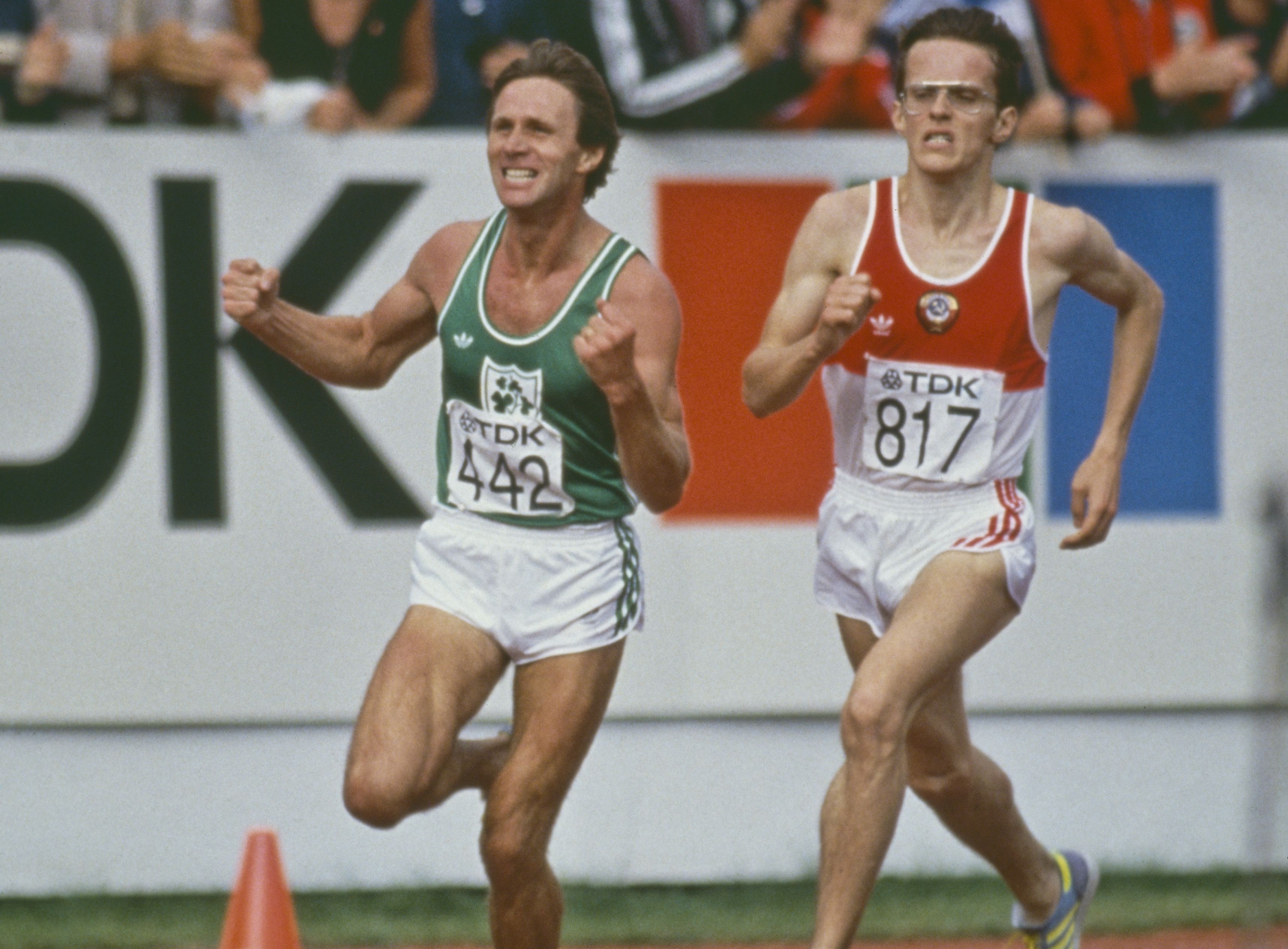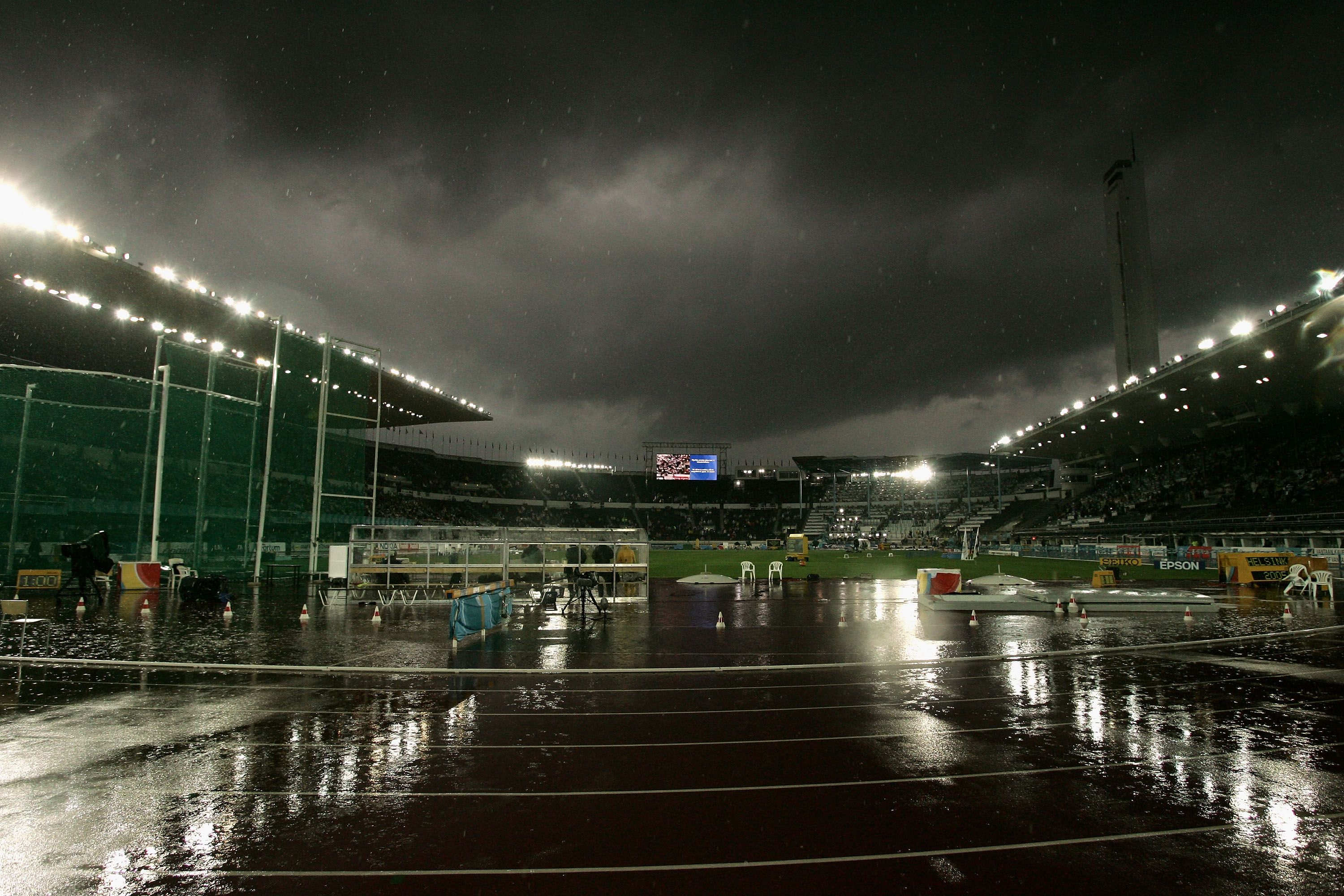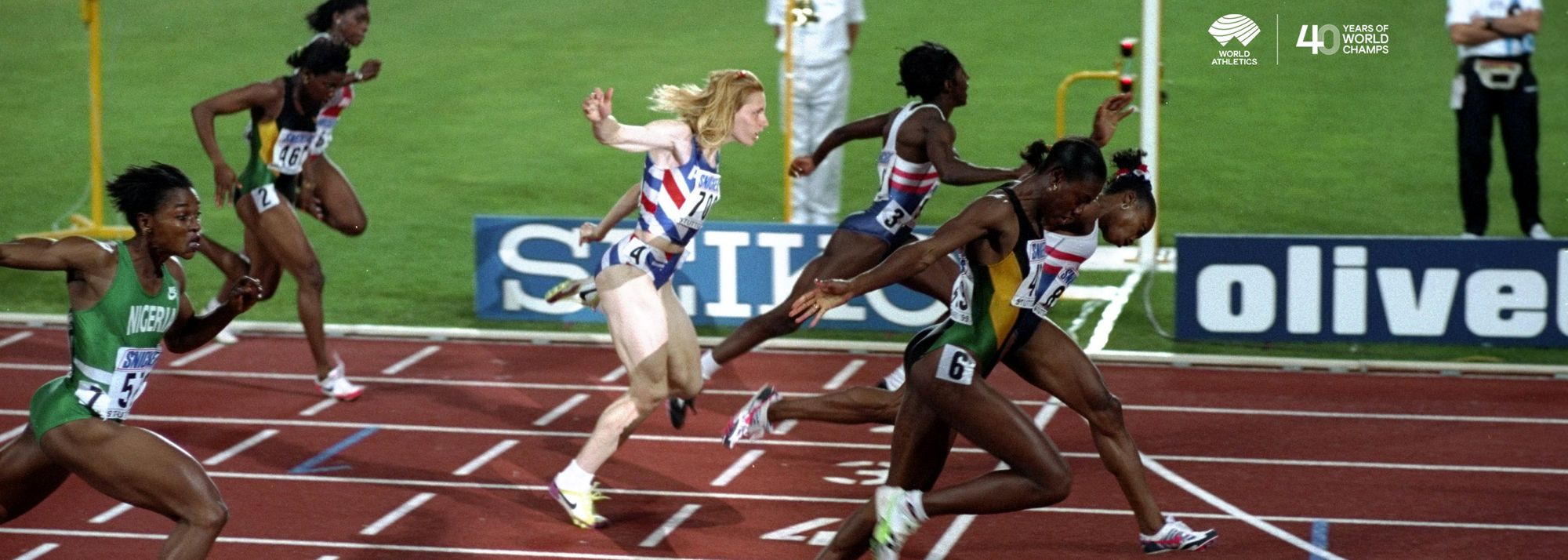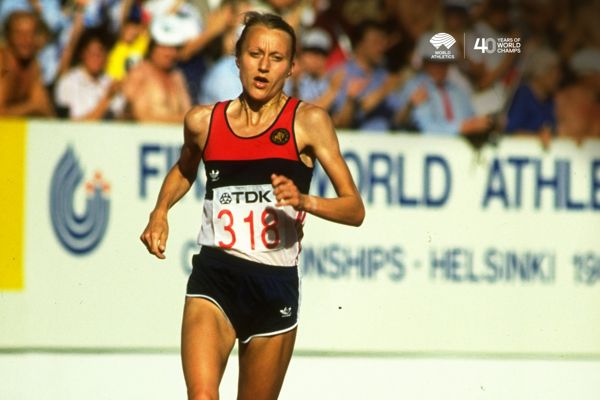Gail Devers and Merlene Ottey fight for the line in the 100m final at the 1993 World Championships in Stuttgart (© Allsport / Getty Images)
Since the inaugural event in 1983, the World Athletics Championships has produced a series of one-offs or surprising occurrences that are remembered and, in some cases, celebrated by the sport’s followers. Ahead of the 40th anniversary of the global showpiece in Budapest in August, here are some tales of the unexpected from the previous editions.
1983 – Glee
The first men’s world 5000m final featured a victory celebration from the runner in second place. Even before his final bend move to pass Dmitriy Dmitriyev, who had led by 12 metres at the bell, Ireland’s Eamonn Coghlan was shaking his fists in anticipatory glee.
After missing a medal by one place in the 1976 Olympic 1500m and 1980 Olympic 5000m finals through – by his own admission – faulty tactics, this time Coghlan was going to get it right. And he knew it. He did so, gliding past his rival to earn a finishing straight run-in to global gold that he – and the sport – has never forgotten.

Eamonn Coghlan passes Dmitriy Dmitriyev in the world 5000m final in Helsinki (© Getty Images)
1983 – Bee
USA’s Carl Lewis was at his blocks before the men’s 100m final, but suddenly started up and walked away. Under 2010 rules he might have been disqualified, but he was OK in 1983 and returned to his mark.
He went on to win the first of his three gold medals in Helsinki. He had been bothered by a bee.
1993 – Closest of calls
At the 1993 World Championships in Stuttgart, Gail Devers of the United States beat Merlene Ottey of Jamaica to the women’s 100m title by just one thousandth of a second, with both women being given the time of 10.82.
Ottey earned prolonged and sympathetic applause at the medal ceremony. She had the consolation of winning the 200m title, recording 21.98 to the 22.00 of the Olympic champion, Gwen Torrence of the United States.
Three years later in the Atlanta Olympic Games 100m final, Devers and Ottey were again given the same time, 10.94. And again, the US sprinter got the nod – this time by 0.005.
2001 – Mind the gap
Kenya’s Charles Kamathi won the men’s world 10,000m title in Edmonton in 2001, clocking 27:53.25 ahead of Ethiopia’s Assefa Mezgebu and Haile Gebrselassie.
After watching Kamathi’s victory, a local dentist offered to replace – for free – his front tooth, which had been missing since 1997.
2001 and 2003 – Flashy dresser
During his 43-race winning streak from 2001 to 2004, during which time he won the 2001 and 2003 world titles, 400m hurdler Felix Sanchez of the Dominican Republic was known for wearing a wristband while competing.
The red flashing wristband, a souvenir from the 2000 Olympics, served as a motivation for him after he failed to advance to the final in Sydney. After winning the Olympic gold medal in Athens in 2004, Sanchez gave the wristband to World Athletics for auction and the profits were donated to charity.

Felix Sanchez wins the 2001 world 400m hurdles title in Edmonton (© Getty Images)
In his first race after the Olympics – and his first race without the wristband – Sanchez injured his leg in Brussels and had to abandon the race halfway through.
In 2012, at the age of 34, Sanchez became the oldest man to win an Olympic 400m hurdles title. He was the only Olympic medallist for the Dominican Republic until 45 minutes after his second gold medal, when Luguelin Santos won 400m silver.
1993, 2003 and 2009 – Shoe issues
At the 1993 World Championships, Quincy Watts’ hopes of adding a world 400m gold to the Olympic title he had won the previous year in Barcelona fell apart on the final bend – along with his shoe – as his US compatriot Michael Johnson earned the first of what would be four world titles at that distance.
At the 2003 World Championships in Paris, Kenya’s Moses Tanui, defending the men’s 10,000m title, was being closely tracked by Haile Gebrselassie. Shortly before the bell, the Ethiopian clipped his heels and loosened his shoe. Beating his head with his fists, Tanui kicked the shoe fully off and made a desperate, lop-sided run for home, but he was caught and passed in the home straight.
After crossing the line in 27:46.02, the Ethiopian – who had received an official warning for baulking runners during the race – tried to shake hands with the irate Kenyan, with a huge lack of success. Tanui waved his retrieved shoe at him, saying: “He kept stepping on my shoes. You tell me how my shoe fell off without him making it happen.”
A Kenyan protest was turned down but there was some good news for the nation, who heard that the disqualification of their 15-year-old Sally Barsosio, who had finished third in the previous night's women's 10,000m final, was declared to have been the result of a technical error. The baulking of the inexperienced runner had caused Elana Meyer of South Africa, the Olympic silver medallist, to quit the race in tears.
In the men’s 5000m heats at the 2009 World Championships in Berlin, Ethiopian newcomer Ali Abdosh lost a shoe on the first lap and spent around 16 seconds trying to put it back on before returning to the race to huge applause. He eventually missed qualifying by three places, but was then given a spot in the final by the referee. He finished sixth in a race won by his compatriot Kenenisa Bekele.
2005 – Rain stops play
A violent thunderstorm in Helsinki halted competition on the fourth day of the 2005 World Championships.

Heavy rain at the 2005 World Athletics Championships in Helsinki (© Getty Images)
The downpour hit track and field events early in the evening session at the Olympic Stadium, with the women's discus final being postponed. Organisers also had to re-stage the men's triple jump qualifying and 200m quarterfinals.
The storm struck after the first heat of the women's 100m hurdles and sent athletes and officials scurrying from the stadium. The decathlon high jump was interrupted and only four throws were possible in the women's discus.
Torrential rain fell for about 90 minutes, flooding the track and the infield, but finals in the men's 3000m steeplechase, women's 800m and the men's 400m hurdles later went ahead as planned.
2009 – Grin and bear it
At the 2009 World Championships in Berlin, after winning the women’s 400m title in 52.42 – the second-fastest time in history – Jamaica’s Melaine Walker leapt on to the back of the event mascot, Berlino the Bear, for a piggy-back victory lap – but soon found herself falling to earth as Berlino collided with a cart of hurdles and dropped her.
There were other unusual victory celebrations in 2009 as home discus winner Robert Harting celebrated gold – achieved with a final round personal best of 69.43m that moved him up from silver – by successfully clearing several hurdles set out for the next track competition and then ripping his vest to tatters.
2011 – Daegu voodoo
At the 2011 World Championships in South Korea, defending men’s 100m champion Usain Bolt produced one of his most effective and wide-ranging shows prior to the final before being disqualified for false-starting. In his absence, gold went to his training partner Yohan Blake. Bolt then concentrated very hard on retaining his 200m title.
After a succession of athletes who featured on the front cover of the 2011 daily programme failed or came to grief, Australia’s Sally Pearson broke the hoodoo to win her first global 100m hurdles title. London 2012 gold followed.

Sally Pearson en route to the 2011 world title in Daegu (© Getty Images)
2015 – Mr YouTube
At the 2015 World Championships in Beijing, Julius Yego won the men’s javelin with a throw of 92.72m, becoming the first Kenyan to win a World Championships gold medal in a field event. He went on to take silver at the following year’s Rio Olympics.
He was nicknamed "Mr YouTube" because he had learned how to throw by watching YouTube videos of javelin athletes.
2022 – A different defence
Polish hammer great Anita Wlodarczyk is better known for global title defences, having won four world gold medals between 2007 and 2017, and three successive Olympic titles since 2012.
But in 2022, she undertook a different kind of defence – one that would rule her out of that year’s World Athletics Championships in Oregon.
The 37-year-old, who had recorded 78.06m to win in Nairobi at the start of May, only had one more month of competition that year as she sustained an injury in June while defending her car – apprehending a criminal who had attempted to steal it.
Mike Rowbottom for World Athletics







